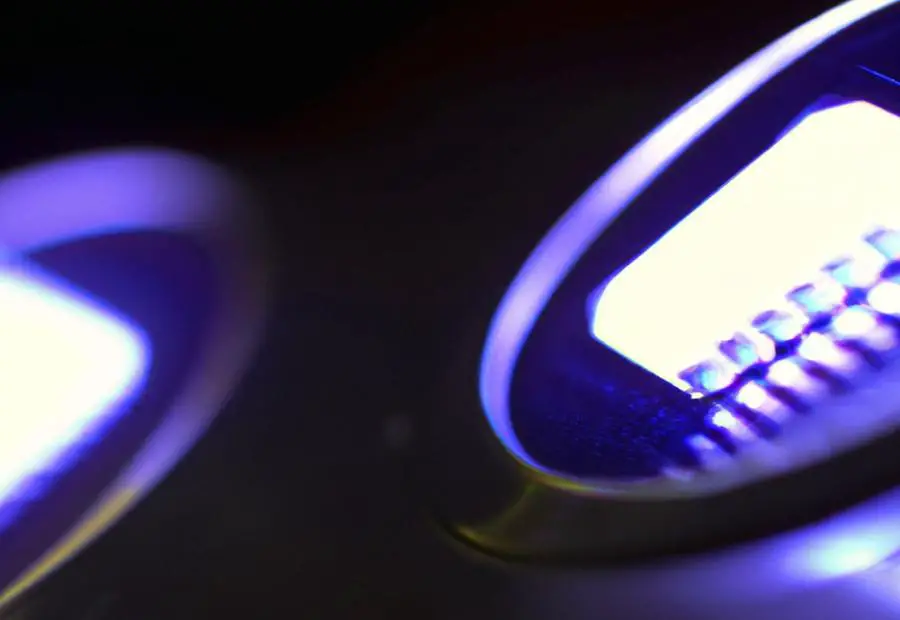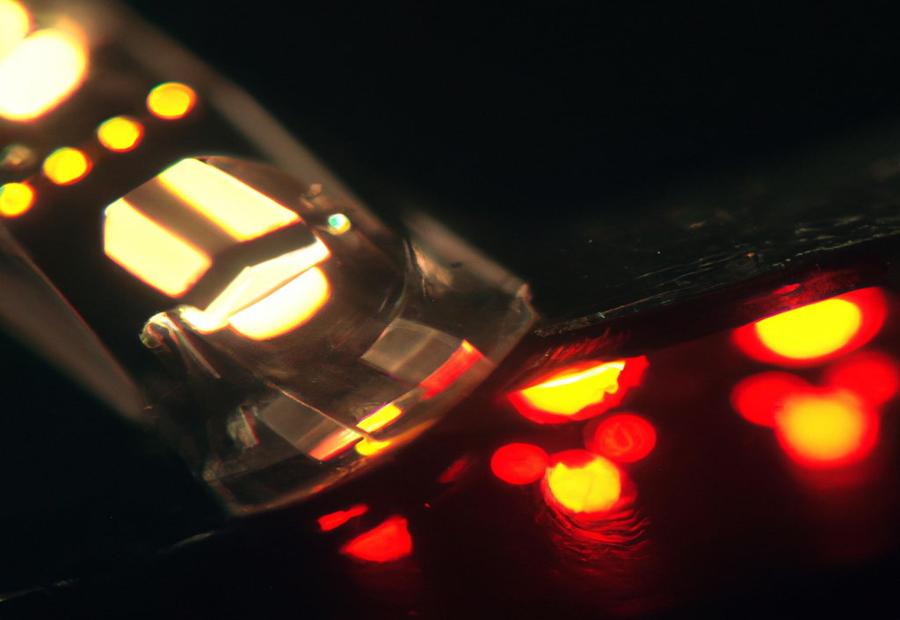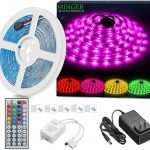Last Updated on 9 months by Francis
.jpg)
Using electronic devices with the correct voltage is crucial to ensure their safe and effective operation. In the context of LED lights, it is essential to understand the implications of using a 110V LED on a 220V circuit. This article aims to provide clarity on this matter.
Understanding Voltage: 110V and 220V
Voltage refers to the electrical potential difference between two points in an electrical circuit. In the United States and some other countries, the standard voltage is 110V, while in many other countries, including Europe, the standard voltage is 220V. It is important to note that using a device with the incorrect voltage can have serious consequences.
Can a 110V LED Be Used on a 220V Circuit?
Using a 110V LED on a 220V circuit can pose significant risks and dangers. Here are some potential issues to consider:
- Potential Risks and Dangers: Operating a device at a higher voltage than its intended rating can lead to electrical shocks, fires, and other safety hazards.
- Damage to the LED: Exposing a 110V LED to a 220V circuit can cause irreversible damage to the LED components, rendering it useless.
- Fire Hazards: The increased voltage can cause the LED to overheat, potentially leading to a fire.
What Happens if a 110V LED is Used on a 220V Circuit?
If a 110V LED is used on a 220V circuit, several issues may arise:
- Overheating: The increased voltage can cause excessive heat buildup within the LED, leading to performance issues and potential failure.
- Reduced Lifespan: Operating the LED at a higher voltage than recommended may significantly reduce its lifespan, resulting in frequent replacements.
- Flickering or Dimming: The LED may exhibit flickering or dimming issues due to the mismatch between the voltage requirements and the circuit’s output.
How to Determine if a LED is Compatible with 220V?
To ensure that a LED is compatible with a 220V circuit, it is vital to check the manufacturer’s specifications and product labeling. LEDs specifically designed for 220V circuits will indicate their compatibility on the packaging or product information.
Alternatives for Using a 110V LED on a 220V Circuit
If you have a 110V LED and need to use it on a 220V circuit, here are a few viable alternatives:
- Using a Voltage Converter: A voltage converter can step down the 220V circuit’s voltage to match the LED’s requirements.
- Using a Step-Down Transformer: Similarly, a step-down transformer can convert the higher voltage to a suitable level for the LED.
- Seeking Professional Assistance: If uncertain, it is wise to consult an electrician or a professional who can guide you in safely using the LED with the appropriate voltage.
Contents
Key takeaway:
- Using a 110V LED on a 220V circuit can be dangerous: There are potential risks and dangers, including damage to the LED and fire hazards.
- Compatibility is important for the LED’s performance: If a 110V LED is used on a 220V circuit, it can lead to overheating, reduced lifespan, and flickering or dimming.
- Alternatives to consider: To use a 110V LED on a 220V circuit, options include using a voltage converter, a step-down transformer, or seeking professional assistance.
Understanding Voltage: 110V and 220V
Understanding voltage is crucial when it comes to electrical devices. It is essential to familiarize yourself with both 110V and 220V systems:
- 110V: This is the standard voltage used in various countries, including the United States. It is commonly found in household outlets and is suitable for most everyday electrical appliances.
- 220V: On the other hand, this higher voltage is utilized in many other countries, such as those in Europe and Asia. It is capable of delivering more power and is commonly found in larger appliances like air conditioners and electric cookers.
- Compatibility: It is important to note that devices designed for 110V may not function properly or safely if connected to a 220V power source. Therefore, always check the voltage requirements of your appliances before using them in different countries.
- Transformers: If you wish to use a 110V device in a country with a 220V power supply, you can utilize a voltage converter or transformer to decrease the voltage. This ensures that the device receives the appropriate amount of power and prevents any potential damage.
- Caution: Attempting to directly connect a 110V device to a 220V power source without a transformer can result in damage to the device and pose a safety risk.
Understanding the voltage requirements of your electrical devices is crucial to ensure their proper functioning and overall safety.
Can a 110V LED Be Used on a 220V Circuit?

Photo Credits: Infraredforhealth.Com by Roger Martinez
Discovering whether a 110V LED can be used on a 220V circuit is crucial to avoid potential risks and dangers. By briefly examining the possibility of damage to the LED and the looming fire hazards, we can gain valuable insights into the compatibility of these electrical components. So, let’s dive in and shed light on this burning question.
Potential Risks and Dangers
The use of a 110V LED on a 220V circuit can pose potential risks and dangers. It is important to be aware of these potential risks and dangers in order to ensure safety and prevent damage.
- Overheating: When a 110V LED is used on a higher voltage circuit, it can lead to excessive heat generation. This can cause the LED to overheat, leading to potential malfunctions and even fire hazards.
- Reduced Lifespan: The higher voltage can accelerate the aging process of the LED. This can result in a reduced lifespan, causing the LED to fail sooner than expected.
- Flickering or Dimming: Incompatibility between the LED and the higher voltage can cause the LED to flicker or dim. This can affect the performance and appearance of the LED light.
To ensure safety and avoid these potential risks and dangers, it is important to use LEDs that are specifically designed and rated for the voltage of the circuit they will be connected to. Always check the specifications and compatibility of the LED before installation.
Damage to the LED
Using a 110V LED on a 220V circuit can result in damage to the LED. When the LED is exposed to a voltage higher than its design, it can cause the internal components to overheat and fail, leading to permanent damage to the LED. This will render it inoperable. Furthermore, the increased voltage may cause the LED to emit a brighter and harsher light, which might not be desirable for certain applications. Additionally, the LED may flicker or dim due to the higher voltage, affecting its performance. Therefore, it is crucial to ensure the LED’s compatibility with the circuit voltage to avoid any potential damage.
Fire Hazards
Using a 110V LED on a 220V circuit can pose significant fire hazards. The higher voltage can lead to overheating, which puts the LED and its surrounding components at risk. Overheating can cause damage to the LED, reducing its lifespan and potentially causing it to malfunction or fail completely. Additionally, the increased voltage can cause flickering or dimming of the LED, indicating a potential electrical issue.
To avoid fire hazards when using a 110V LED on a 220V circuit, it is crucial to ensure that the LED is compatible with the higher voltage. Always check the specifications and labeling provided by the manufacturer to determine if the LED can handle the increased voltage. If the LED is not designed to work with 220V, it is recommended to seek professional assistance. Professionals can help modify the circuit or provide alternative solutions to ensure safe usage of the LED.
What Happens if a 110V LED is Used on a 220V Circuit?
What happens if you use a 110V LED on a 220V circuit? Buckle up as we delve into the potential consequences of this mismatched voltage adventure. From overheating to reduced lifespan, and even flickering or dimming, we’ll uncover the electrical dance that unfolds when these two worlds collide. Get ready to witness the sparks of knowledge as we explore the risks and pitfalls of using a 110V LED in a 220V circuit.
Overheating
When a 110V LED is used on a 220V circuit, overheating can occur. The increased voltage leads to a higher current flowing through the LED, causing it to generate excessive heat. Overheating can have detrimental effects on the LED and the circuit it is connected to.
Overheating can damage the LED, leading to a shortened lifespan and reduced performance. The excessive heat can degrade the components of the LED, causing it to dim or flicker. In severe cases, the LED can even burn out or melt, posing a fire hazard.
To prevent overheating when using a 110V LED on a 220V circuit, it is important to ensure that the LED is compatible with the higher voltage. Some LEDs are designed to handle a wider voltage range, including 220V. Using these LEDs can effectively mitigate the risk of overheating.
Pro-tip: Before using a 110V LED on a 220V circuit, always check the specifications of the LED to ensure compatibility with the higher voltage. It is recommended to consult a professional electrician if you are unsure about the compatibility or need assistance with the installation to avoid any potential hazards.
Reduced Lifespan
Using a 110V LED on a 220V circuit can result in a reduced lifespan for the LED. When the LED is exposed to higher voltage than it is designed for, it can cause the internal components to overheat and wear out faster, leading to a shorter overall lifespan. It is important to note that using a 110V LED on a 220V circuit is not recommended and can void the warranty of the LED.
To ensure the longest lifespan for your LED, it is best to use a LED that is specifically designed for the voltage of your circuit. This will ensure that the LED is operating at its optimal performance and is protected from potential damage. It is a fact that LEDs have a much longer lifespan compared to traditional incandescent or fluorescent bulbs. On average, LED bulbs can last up to 25,000 to 50,000 hours, depending on the quality and usage. This is significantly longer than the lifespan of incandescent bulbs, which typically last for around 1,000 hours.
Flickering or Dimming
The use of a 110V LED on a 220V circuit can result in flickering or dimming of the light. This occurs due to the mismatch between the voltage requirements of the LED and the supply voltage.
- Flickering: Connecting a 110V LED to a 220V circuit may cause it to flicker. This is because the LED is not designed to handle the higher voltage, leading to irregular power supply. The flickering can be distracting and affect the overall lighting experience.
- Dimming: Another consequence of using a 110V LED on a 220V circuit is the dimming of the light output. The LED may not be able to reach its full brightness due to the higher voltage, resulting in a less bright illumination. This can impact the visibility and functionality of the LED light.
It is crucial to ensure compatibility between the LED and the circuit voltage to avoid issues like flickering or dimming. Utilizing the correct voltage or employing alternatives such as voltage converters or step-down transformers can ensure the proper functioning of the LED and prevent potential damage or hazards. Seeking professional assistance is recommended to determine compatibility and make necessary adjustments for a consistent and optimal lighting experience.
How to Determine if a LED is Compatible with 220V?

Photo Credits: Infraredforhealth.Com by Willie Thomas
If you want to know how to determine if a LED is compatible with 220V, follow these steps:
- Check the specifications: Look for the LED’s voltage rating. If it is rated for 220V or higher, it is compatible.
- Check the power supply: Verify if the LED requires an external power supply. If it does, ensure that the power supply is compatible with 220V.
- Check the driver: LEDs often require a driver to regulate the voltage. Confirm that the driver supports 220V input.
- Look for international symbols: Some LEDs have symbols like “100-240V” indicating they can work within a range of voltages, including 220V.
- Consult the manufacturer: If you are still unsure, reach out to the LED manufacturer for more specific information on compatibility with 220V.
By following these steps, you can determine if a LED is compatible with 220V without any guesswork or potential damage to your LED.
Alternatives for Using a 110V LED on a 220V Circuit

Photo Credits: Infraredforhealth.Com by Elijah Rodriguez
Looking to use a 110V LED on a 220V circuit? Don’t fret! In this section, we’ll explore some alternatives to make it work seamlessly.
From using a voltage converter to opting for a step-down transformer, we’ll cover a range of options to safely power your 110V LED on a 220V circuit.
And if you prefer a hassle-free approach, we’ll also discuss when it’s best to seek professional assistance.
So, let’s dive in and find the perfect solution for your illuminating needs!
Using a Voltage Converter
When it comes to using a 110V LED on a 220V circuit, using a voltage converter is a viable option. Here are the steps to follow:
- Research the appropriate voltage converter that can handle the power requirements of your LED. Look for a converter that specifically states it is suitable for LED lights.
- Purchase the voltage converter that matches the wattage and voltage needs of your LED. Make sure it has the necessary input and output specifications.
- Connect the 110V LED to the output side of the voltage converter.
- Plug the voltage converter into the 220V circuit.
- Turn on the power to the circuit and ensure that the voltage converter is functioning properly.
Using a voltage converter allows you to safely use a 110V LED on a 220V circuit without risking damage to the LED or potential hazards such as fire. It ensures that the LED receives the appropriate voltage for optimal performance and longevity. Remember to always follow the manufacturer’s instructions and consult a professional if you are unsure about the compatibility or installation process.
Using a Step-Down Transformer
When using a 110V LED on a 220V circuit, one option to ensure compatibility is using a step-down transformer. Here is a step-by-step guide:
- Ensure the LED is suitable for use with a step-down transformer. Check the voltage specifications provided by the manufacturer.
- Purchase a step-down transformer that can convert the 220V power supply to 110V. Make sure the transformer wattage is higher than the LED’s power consumption.
- Connect the step-down transformer to the 220V circuit by plugging it into a power outlet or wiring it directly.
- Plug the LED into the secondary outlet of the step-down transformer, which provides the converted 110V power.
- Test the LED to ensure it is functioning properly. If any issues arise, disconnect the power immediately and verify compatibility or seek professional assistance.
Now, for a true history related to using a step-down transformer: During the early days of electricity, when voltage standards were not standardized, appliances and devices had varying voltage requirements. In order to use them in different locations, people would often employ step-down transformers to convert the voltage. For example, when traveling with electrical gadgets, individuals would use step-down transformers to adapt their devices to the voltage available in different countries. These transformers played a crucial role in making electrical appliances more versatile and accessible across different regions.
Seeking Professional Assistance
When dealing with the issue of using a 110V LED on a 220V circuit, it is highly recommended to seek professional assistance.
Consulting with an electrician or qualified professional who specializes in electrical systems and LED lighting is important. They have the expertise to assess the compatibility of the LED with the higher voltage circuit and provide appropriate solutions.
Professional assistance can help prevent potential risks and dangers associated with using the LED on an incompatible voltage. They will evaluate the LED’s specifications and determine if it can withstand the higher voltage without causing damage or fire hazards.
By seeking professional advice, you can ensure the safe operation of the LED and avoid issues such as overheating, reduced lifespan, flickering, or dimming.
Professional electricians can also offer alternative solutions, such as using a voltage converter or a step-down transformer, instead of using a 110V LED on a 220V circuit. They will recommend the most suitable option based on your specific requirements.
Remember, seeking professional assistance is essential to ensure the proper functioning and longevity of your LED lighting system when dealing with voltage compatibility issues.
Some Facts About “Can 110v LED Be Used on 220v”:
- ✅ Using a 110v LED on a 220V circuit can cause the bulb to burn out quickly or even result in a fire. (Source: Our Team)
- ✅ Plugging a 110v LED into a 220V socket can lead to the filament not receiving enough current, affecting the bulb’s brightness. (Source: Our Team)
- ✅ Adapters or transformers can be used to convert the voltage from 220V to 110V in order to safely use a 110V LED bulb. (Source: Our Team)
- ✅ The wattage of a 110V LED bulb should not exceed the rating of the converter or transformer when using it on a 220V circuit. (Source: Our Team)
- ✅ Using a 120V LED bulb on a 220V circuit with the appropriate converter or transformer can be a viable option. (Source: Our Team)
Frequently Asked Questions
Can a 110V LED be used on a 220V power supply?
In most cases, a 110V LED cannot be used on a 220V power supply. The LED bulb is not designed to handle the higher voltage and may be damaged. It is best to use bulbs that are specifically rated for the voltage of your power supply to ensure safety and optimal performance.
What are the safety issues of using a 110V LED on a 220V power supply?
Using a 110V LED on a 220V power supply can pose several safety issues. The bulb may overheat, leading to a potential fire hazard. It can also cause the bulb to burn out quickly or result in dim lighting. To avoid these safety concerns, it is recommended to use bulbs that are compatible with the appropriate voltage.
Is it safe to use a LED corn light rated for 220-240V on a 110V power supply?
Using a LED corn light rated for 220-240V on a 110V power supply is not recommended. The bulb is not designed to operate at a lower voltage and may not function properly. It is important to use bulbs that match the voltage of your power supply to ensure both safety and optimal performance.
Should I only buy LED bulbs with UL markings for safety?
UL markings indicate that a product has met specific safety standards set by Underwriters Laboratories. While it is recommended to choose LED bulbs with UL markings for added safety assurance, the absence of such markings does not necessarily mean the bulb is unsafe. It is important to consider other factors such as the reputation of the manufacturer and any independent safety certifications obtained.
Can I use an extension cord to connect a 110V LED to a 220V power supply?
Using an extension cord to connect a 110V LED to a 220V power supply is not recommended. The voltage mismatch can cause the LED bulb to burn out quickly or lead to other safety issues. It is best to use bulbs that are specifically designed for the voltage of your power supply and avoid using extension cords for this purpose.
Is it possible to convert a 220V power supply to work with a 110V LED bulb?
Yes, it is possible to convert a 220V power supply to work with a 110V LED bulb by using a voltage converter or transformer. These devices can convert the higher voltage to the appropriate level for the LED bulb. However, it is important to note that using a converter or transformer may affect the performance and efficiency of the bulb.

.jpg)
.jpg)

.jpg)


